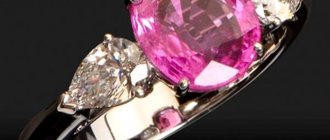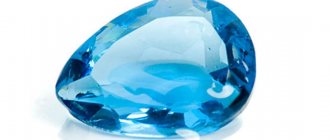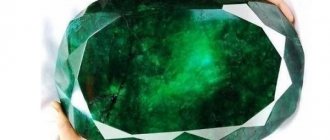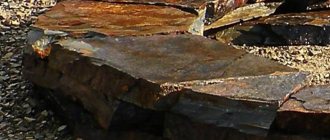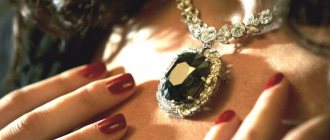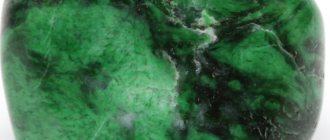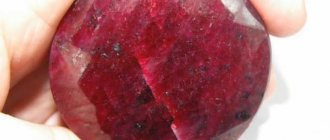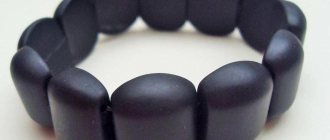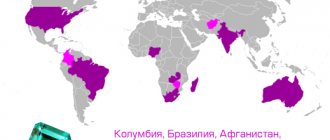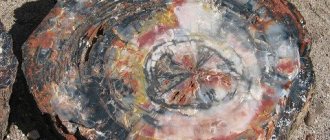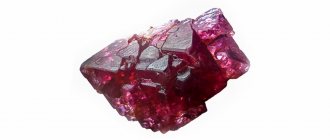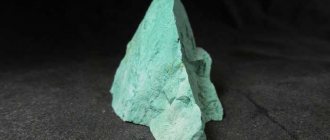Known since biblical times, the emerald gemstone was loved by Egyptian pharaohs, Roman and Mongol emperors, Turkish sultans, Iranian shahs and Russian tsars. The emerald jewelry of the Great Mogul Babur (16th century), the founder of the Mughal Empire, is still kept in Tehran. The Bible speaks of an emerald in the breastplate of the high priest Aaron . Emerald is the favorite stone of the Egyptian queen Cleopatra (51-30 BC), and the Swedish queen Ulrika Eleonora in the 16th century equipped entire expeditions to distant countries to obtain it.
The most outstanding five intricately shaped Peruvian emeralds, which were given to his bride by the Spanish conquistador Fernando Cortez , were lost in the mid-16th century. But their fame has survived to this day. The largest private collections of emeralds are kept in Iran and Turkey. Modern cinema and pop culture stars, members of royal families and European aristocrats are trying to comprehend the magical secrets of emerald.
Place of Birth
Good emeralds are rare, most of them are found in the Colombian deposits of Tunja (the deposit was discovered in 1555) and Muso (known since 1537), in New Granada, Zambia, Brazil and Egypt.
Emeralds of lower quality are found in Habachtal, in Salzburg (Austria), in the Mourne mountains (Ireland), on Lake Mjoesen (Norway) and in some other places. Emeralds are also mined in Russia, USA, Canada, Australia, Spain, France, Switzerland, Italy, Germany, Bulgaria, Kazakhstan, Pakistan, Afghanistan, India, China, Cambodia, Egypt, Ethiopia, South Africa, Somalia, Nigeria, Namibia, Tanzania, Zimbabwe, Mozambique and Madagascar.
Deposits and processing of precious stones
Mineral mining is carried out in many countries:
- Colombia;
- Brazil;
- Russia;
- Zambia;
- Egypt;
- New Granada;
- USA;
- Argentina;
- Zimbabwe;
- Austria;
- Norway;
- France;
- India;
- Spain;
- Italy;
- Germany;
- Kazakhstan;
- Switzerland;
- Afghanistan.
Rating of the best emeralds:
- Colombian emeralds are of the best quality. Even an unprocessed mineral has a high cost, because it is perfect.
- Brazilian emeralds are not far behind. The most famous stone mined in Brazil is the Bahia emerald.
- These two options compete with Russian gems. Emerald mining in Russia is carried out in the Urals at the Malyshevskoye deposit. Yakut (Siberian) gems are known, but in fact these are chrome diopsides.
- One of the inexpensive representatives includes Indian emerald.
The mineral is mined in mines using explosives, since clusters of emeralds in the ground are located at some depth. After the explosion, workers select pieces of rock and send them from the bottom of the mine to the top. The resulting material is sent to the factory, where workers select good samples.
The treatment is named after the mineral - emerald cut (step). It is applied to most crystals. Cloudy defective samples become cabochons.
When working with the mineral, jewelers carefully polish the edges in order to improve the reflective and refractive properties, obtaining faceted emeralds of various shapes (“Drop”, “Pear”, “Heart”, classic round, oval and others).
Watch a news video about a major discovery of a precious mineral:
Types of emeralds
Varieties of emeralds found in nature are usually distinguished depending on the place of extraction.
Emeralds of Colombia
Nowadays, from 50 to 95% of all emerald production comes from Colombia (the exact percentage varies greatly from year to year in different directions). Between 2000 and 2010, emerald production in Colombia increased by 78%. In addition to regular emeralds, Colombia also produces trapice emerald, which is distinguished by the formation of crystals in the shape of a wheel with spokes.
Colombian emerald Unguentarium
Emeralds of Zambia
Zambian emeralds are of higher quality than Colombian ones. Zambia's largest emerald deposit is the Kagem mine, which is located 45 km southeast of the city of Kitwe. In 2004, about 20% of all emeralds mined that year were mined here, making Zambia the second “emerald” country after Colombia. In the first 6 months of 2011, 3.74 tons of emeralds were mined in the Kagem mines.
Zambian emeralds
Emeralds of Brazil
Stones mined in Brazil are lighter and much purer than Colombian ones. It was also here that the world's largest emerald was found at 57,500 carats (11.5 kg), named Teodora and approximately valued at $1.15 million.
Emerald Teodora
Emeralds of Egypt
In Egypt, emeralds are mined in mines near El Quseir and Mount Zabara (this deposit, according to hieroglyphic monuments found there, was mined already in 1650 BC).
Deposits near Aswan, 50-60 km from the Red Sea coast, were developed under Pharaoh Sesostris III about 37 centuries ago. Slave miners dug shafts up to 200 meters deep in strong shale, which could accommodate up to 400 people at a time.
It was believed that emerald was afraid of light, so the work was carried out in complete darkness. On the surface, the emerald-bearing rock was split into pieces and smeared with olive oil in order to distinguish the precious crystals.
Ancient Egypt jewelry with emerald
Emeralds of Afghanistan
Or the Panjshir Emeralds, mined in the upper reaches of the Panjshir Gorge, in the area of Pawat, in the villages: Piryakh, Mabain, Zaradhak - 10-13 kilometers southeast and east of the village of Pishgor, in each of which from 20 to 40 mines were concentrated, and Also in the Darkhinj gorge there are significant deposits of emeralds.
During the Afghan War (1979-1989), the development of emeralds in the Panjshir Gorge was under the control of a major field commander, Ahmad Shah Massoud. After mining, the emerald was sent to Pakistan for processing, and from there distributed to international markets.
The amount of funds received for emeralds during this period averaged up to $10 million per year. Mining work on rocky soils was carried out by Japanese drilling rigs with the involvement of Western European engineers.
Afghan emeralds
According to jeweler Oded Burshtein, Afghan emeralds are an equal alternative to emeralds from Colombia and Zambia, they compete equally in beauty, and even better quality, since the crystal of the Afghan emerald is cleaner and denser, and emits more bright shine, has a unique shade and hardness when cut , due to the natural hardness of the crystal itself.
“Only by acquiring an Afghan emerald can you truly appreciate its beauty, rich brilliance, durability and unique green hue. And the fact that there are very few green beryls from Afghanistan on the gemstone market makes them even more desirable.”
— Oded Burshtein “Inbar Fine Jewellery.”
Ural emeralds
The emerald mines of the Urals were discovered by Maxim Kozhevnikov and Yakov Kokovin in 1831 at the confluence of the Tokovaya River and the Bolshoy Reft River, 90 km northeast of Yekaterinburg. They are famous for their emerald crystals, unique in size, as well as alexandrite and phenacite.
Ural emeralds
During the first century of development, more than 15 tons of precious stones were mined here. The emerald mining area is 25 km long and 2 km wide; there are several deposits located here, including Malyshevskoye. In these bedrock deposits, emeralds are found embedded in carbonaceous limestone and mica schist.
Story ?
- The legend of Cleopatra's mines would have been considered a legend. But at the beginning of the 19th century these famous mines were found. True, the emeralds were no longer there, but archaeologists found miners' tools.
- But it is known for sure that in Ancient Rome the aristocracy admired green gems. Another legend is that Emperor Nero, when watching gladiator fights, used a plate (or lens) made of emerald.
- In South America, the Incas mined emeralds. Expeditions of the Spaniards robbed the local population and exported large quantities of precious stones to Europe.
Then European residents (who could afford it) excitedly began buying jewelry with emeralds.
Colombian Unguentarium emerald weighing 2860 carats. Presented in the Vienna Treasury
This is a huge emerald (167.97 carats or 33.594 g) embedded in a platinum pendant. In 1931, this necklace became a wedding gift from Clarence Mackay to his wife. Since then the stone has been called the "Mackay Emerald"
Scientists about emerald?
Theophrastus writes that the following data was discovered in Egyptian archives. The Babylonian king sent the Egyptian king a gift of emerald four cubits long and three cubits wide. In the Egyptian temple of Jupiter there was an emerald obelisk forty cubits high and four cubits wide on one side.
However, it is unknown whether this obelisk was made of emerald.
- Pliny speaks of 12 varieties of emerald.
- Biruni examined in detail the varieties of emerald colors: green color is generally inherent in emerald; There is no other emerald other than green.
It comes in four varieties:
- green is the color of myrrh , like the color of fresh beet leaves and the color of fresh barley shoots.
- fringe; in water and shine it corresponds to the color of myrtle.
- dense green; called Maghreb because of the propensity of the inhabitants of the Maghreb for it;
- asam (deaf) has a less bright green color, is poorer in water and less radiant.
Did they call it as best they could?
Different peoples gave their name to “green ice”.
- The Persians called the gem zummurud.
- In India, the gem was called marakata.
- The Greeks and Romans called emerald not only emerald, but also many green stones that are not identified with certainty.
Magical properties of emerald
Gold ring with emeralds
The magic of emerald extends to many areas of human life.
With it you can:
- Get rid of bad habits and bad inclinations: deceit, tendency to fraud and theft, laziness and debauchery.
- The stone is endowed with the ability to enhance the best qualities that its owner has.
- If the owner of the stone continues to remain in the grip of the above vices, the emerald will not only stop helping him, but will also begin to openly harm him.
Having exhausted its strength, the crystal will simply split.
Also:
- Improve financial well-being.
- Protect your home from danger and black magic.
- Detect adultery.
- Establish friendly relationships in the family.
- Find your life purpose by becoming more reasonable and wiser. It is not for nothing that emerald is called the stone of teachers and sages.
- Establish a connection with the other world and establish contact with the souls of the dead. With its help, people involved in magic and the occult can easily decipher the meaning of signs and answers sent by supernatural forces.
Medicinal properties
Brooch with emerald Hooker
The value of natural emerald lies not only in its beautiful appearance, but also in its healing power. Since ancient times, the powder from this nugget was used as an antidote, a remedy against night blindness, and an eyesore. Healers have long believed that if you hold a stone in your mouth, you can get rid of diabetes, dysentery and even psoriasis.
The healing properties of the gem are not limited to this. It is used for different conditions:
- therapy for mental disorders;
- emerald has a pronounced antibacterial effect;
- helps normalize blood pressure;
- relieves pain in the stomach and joints, improves memory, develops flexibility of thinking;
- eliminates insomnia;
- relieves allergies, asthma, bronchitis;
- relieves inflammation in genitourinary pathologies.
Beryl or emerald: which mineral will bring health
In this matter, the situation is the same as with the magic of minerals. Emerald will certainly give you all the healing capabilities of beryl and at the same time add some special healing properties.
Beryl itself is an excellent guardian of human health. It stimulates the body's immune forces, making it more resistant to various diseases. In addition, this stone has a particularly beneficial effect on the gastrointestinal tract, improving metabolic processes and freeing the body from toxins.
In lithotherapy, a medical practice in which doctors use only natural stones for treatment, beryl is used to heal all kinds of colds and back pain.
Emerald, in addition to the healing properties of beryl, has additional abilities.
- So, it has an excellent effect on the cardiovascular system and helps normalize blood pressure.
- Lithotherapists use the stone to combat, first of all, unhealthy mental conditions. It is believed that the mineral helps get rid of the feeling of chronic fatigue, depression, unreasonable fears, insomnia, etc.
- But the gem is also used to save from diseases of the stomach, kidneys and bladder.
- By the way, emerald is also famous for its antibacterial properties. If you put it in water for a while, you can safely drink it without boiling or filtering.
Talismans and amulets
Gold belt of the Shah with an emerald weighing 176 carats.
Kept in the National Treasury of the Central Bank of Iran in Tehran For a long time, the emerald has been considered a talisman for mothers.
By protecting a woman during pregnancy and during childbirth (thanks to its effect, the threat of premature birth disappears, pain during contractions is reduced, and ruptures are minimized), it contributes to the birth of a healthy child.
Subsequently, the gem will help the mother not only better understand the needs of the baby, but also build a harmonious relationship with him.
Also:
- A crystal placed at the front door or lying on the desktop is an excellent amulet that protects the house from evil spirits and unkind people.
- A young family using an emerald as a talisman will be able to avoid betrayal, conflicts and quarrels, and will find happiness and harmony. It will protect spouses who have lived together for more than one year from fading feelings: it is not for nothing that the 55th anniversary of marriage is called the emerald wedding.
- For unmarried girls, the gem will become a reliable amulet that helps maintain chastity.
- The emerald amulet will bring wealth and good luck to travelers, and will protect sailors from bad weather and storms.
- Creative people and businessmen can use it as an amulet that brings inspiration and success.
The crystal, which plays the role of a love amulet, is recommended to be worn on the ring finger or little finger.
Emerald - unlike most minerals - can be passed on by inheritance. All its positive qualities are preserved.
What was the name for emerald in Russia in the old days?
Smaragd, being valuable, was very loved in Rus'. However, they received it only from overseas regions, or rather from India, where at that time it was in abundance. If you believe written sources, emerald was used at that time even in the manufacture of glasses, which, of course, are inferior in quality to today's glass glasses.
But at that time, only wealthy and influential people could afford to wear glasses. Also, emerald (as it was called in the old days, emerald) was a desirable adornment for every beauty of those times, and even now many enjoy wearing it as a fashion accessory.
Today, Russia (Ural Mountains) and Brazil are considered the record holders for the extraction of this gem. Therefore, when people think about how emerald was called in the old days in Russia, they mistakenly attribute the ancient Latin name to the original Russian one. By the way, the best cutting and polishing of emeralds is done by Dutch jewelers. People who are interested in astrology and esotericism consider emerald to be a wonderful talisman. Stones come in either a green tint or a blue tint - this depends on the quality of polishing and cutting. It turns out that the largest emerald ever caught by man weighed more than 200 kilograms. It is noteworthy that the ancient Slavic name for emerald is still preserved in the Ukrainian language. For example, “The Wizard of the Emerald City” is translated into Ukrainian as “Charivnyk of the Emerald Mist.”
Areas of application
Emerald crystals
The main use of emeralds is in the production of jewelry.
Stones of a deep green tone are most valued; even if there are inclusions, they are preferred to be pale colored, even almost transparent.
To process transparent emeralds, the following types of cuts are used: step, rectangular “emerald” or “square”, less often diamond. Translucent stones are processed in the form of cabochons.
Dichroism must be taken into account.
It should be noted that only a very small part of emeralds is processed in the countries where they are mined. The highest quality emeralds are processed in Idar-Oberstein (Germany), Ramat Gan (Israel), London, Geneva and New York. Medium and low quality stones, which make up the bulk of mined minerals and are suitable for making cabochons, are processed in India. They are often combined with diamonds in jewelry.
The luster of emerald is usually vitreous. The physical properties, especially density, light and birefringence, as well as pleochroism, vary somewhat among emeralds from different deposits.
The quality of jewelry stones is assessed in accordance with international requirements. The most valuable are bright green crystals with minor inclusions. Bright color is the main factor influencing the price.
Emerald inserts adorn many pieces of jewelry stored in museums or state treasuries.
Emeralds are also used to create solid-state lasers. Synthetic emeralds are used in quantum electronics.
Physical and chemical properties
Emerald is a mineral belonging to the beryl group. The green color is given to it by impurities of chromium, vanadium or iron oxides. The stone is resistant to acids and other chemicals, and when heated to a temperature of 700 degrees, it becomes discolored. Emeralds rarely have an ideal structure; most often, the inside is riddled with chips and cracks. Therefore, being quite hard, they are very sensitive to shock and compression.
| Formula | Be3Al2Si6O18 |
| Color | Light to deep green, may have a yellowish or bluish tint |
| Probable impurities | Iron oxide (Fe2O3), vanadium oxide (V2O3), chromium oxide (Cr2O3) |
| Shine | Glass |
| Hardness | 7,5-8 |
| Transparency | Transparent, translucent, opaque |
| Strength | Fragile |
| Kink | Uneven, conchoidal |
| Cleavage | Imperfect |
| Density | 2.69-2.78 g/cm3 |
| singonia | Hexagonal |
| Refractive index | nω = 1.564—1.595, nε = 1.568—1.602 |
Emerald products and jewelry
Tiara of the Duchess of Anjou, contains 40 emeralds and 1031 diamonds.
Made in 1819-1820. in Paris Emerald is used for jewelry of all types. They are worn on special occasions, with a wardrobe of the same level.
Pairs with rubies or sapphires. The height of chic is a scattering of diamonds around a stone in gold or platinum.
Gold jewelry is the best gift for a woman on a special occasion. Earrings, bracelet or necklace are given for the birth of a child. An emerald ring is bought for an engagement or wedding.
The men's assortment includes a massive platinum or silver ring, a tie clip, and cufflinks with a rectangular translucent emerald.
The modern bohemian trend is deliberately careless large jewelry with unpolished inserts. Silver is light or blackened.
The stone is valued based on color and origin (stone cost per carat):
- bright green - $2000;
- pale - $500;
- artificial - $200.
Price of emerald jewelry:
- in gold: earrings - $130-500, ring - $100-300;
- with diamonds: ring - $200-500, pendant - $70-200, earrings - $150-700.
Silver accessories are equipped with nanocrystal inserts. The price of such emeralds is several times less than natural material. For example, a ring costs about $30, earrings - $25-30.
The name of emerald in the old days
The Latin language became the ancestor of many languages; it laid down the basic church concepts and enriched many languages with scientific and philosophical terms.
Once upon a time, this language was a universal means of communication among priests, scholars and nobles. Knowledge of this language was considered the highest merit among the intelligentsia, as it opened many roads to the inquisitive mind of the person who speaks it. What was the name for emerald in the old days? The Latin word for emerald, smaragdus, can literally be translated as "green." The fact is that a language so complex in the construction of speech patterns was built on simple concepts: an object or quality was often assessed and named by its properties and color. From here it is easy to guess that the Russian language, absorbing all new items and meanings with incredible speed, has adopted the overseas word. Therefore, it is not difficult to guess what emerald was called in ancient times in Rus'. This stone was called Smaragd, almost completely borrowing the word “from beyond the hill.”
How to distinguish an original from a fake
Colombian emeralds
The stone’s belonging to the huge beryl family, as well as developed technologies for the production of artificial stones, create a real haven for unscrupulous sellers. They can sell cheaper emerald “relatives” at a price close to the cost of the gem. Also, many of them sell laboratory crystals or even pieces of glass.
In order not to make a mistake when buying an expensive gem, you need to remember what an emerald looks like if you examine it carefully.
- Emerald tends to change its hue depending on the angle at which it is viewed. This property is called dichroism. By turning the stone, you can see how it turns from dark green to bluish or vice versa.
- Natural emeralds, at least jewelry examples, always have a velvety hue. Light green, light green, “bottle” stones are crystal-like beryls of cheaper varieties, or synthetics.
- Natural gems are almost never perfect. Those that do not have cracks, air bubbles, abrasions or “grains” of a different color are more expensive than diamonds. You will never see them in regular jewelry stores; these are collector's items. Defects can be examined with a magnifying glass. If they are not there, you have a laboratory stone in front of you.
South African emeralds
Its passport can also tell a lot about a gem. If it contains the phrase “hydrothermal emerald,” it means that the stone was grown in a laboratory. This crystal is completely identical to the best specimens from Colombia. The technologies used to produce these minerals are considered a trade secret.
Gems of this type are free from flaws, have a rich color and a bright play of light. But their cost is much lower than that of natural emeralds, so when they try to sell such a specimen at the price of a genuine one, it is a fraud.
For those who plan to buy a crystal for use in magical practices, hydrothermal stone is not suitable. Only natural gems have magical properties. This is due to the fact that real minerals grow in the earth for thousands of years, absorbing cosmic and earthly energy. Laboratory specimens, no matter how beautiful they are, simply do not have the time to acquire the appropriate energy.
Origin
Emeralds are formed by the interaction of acidic magma with host ultramafic igneous rocks, so their deposits are represented by greisenization zones. Occasionally, small emeralds are formed in the exocontacts of pegmatites.
In most deposits of the world, emerald is associated with phlogopite mica, formed as a result of greisenization - the impact of high-temperature aqueous solutions on ultrabasic rocks. As a result of this process, the original rocks, due to the feldspars of granites, are transformed into complex rocks containing quartz, light mica and often valuable ore minerals in the form of inclusions. The presence of greisen is a leading search indicator for deposits of rare metal ores and precious stones, including emerald.
The best quality emeralds are confined to hydrothermal veins located in carbonaceous shales. Colombian emeralds occur in low-temperature carbonate veinlets cutting through black bituminous limestones.
Since emerald is close in density to quartz, alluvial placers of this stone are usually not formed; secondary deposits are represented only by weathering crusts.
Artificial emerald
Synthetic cut emerald
Artificial emeralds are similar to natural stones, but their density and refractive indices are lower than those of natural ones. Synthetic emeralds have a very distinctive rich bluish-green color, although some Colombian emeralds have similar properties. Through the Chelsea filter they appear intensely red - significantly redder than most natural emeralds.
Regular and artificial emeralds are distinguished using filtered ultraviolet radiation (360 nm), to which real emeralds do not normally react, but synthetic emeralds exhibit chestnut-brown luminescence.
However, this rule is not always confirmed. Many natural emeralds can also react to filtered ultraviolet light.
Currently, industrial methods have been developed for the synthesis of emerald, which is indistinguishable from natural in color and superior in quality.
But the cost of synthetic emerald on the international market remains tens of times lower than natural emerald, since natural emerald is less common. It is possible to grow synthetic emeralds of quite large sizes, up to hundreds of carats.
Artificial emeralds
The production technology is kept secret. For example, the Carroll Chatham Laboratory, California, USA, only accepts workers with incomplete secondary education. It is known that crystals are grown using the flux method in a platinum crucible on a natural emerald seed. In addition, crystal growth is very sensitive to voltage surges.
Since the second half of the 19th century, specialists from several countries have tried to solve the problem of emerald synthesis. The first successful experiments date back to 1888 (France), but a full-fledged artificial emerald was obtained only in 1935 in Germany by the scientist G. Espigue and his colleagues and was named “igmerald” - after the first letters of the company name and the English “emerald” - emerald . Since 1940, the Americans have established industrial production of Igmerald.
Today, emeralds are also produced in Germany, France, Switzerland, Japan, Russia and Belarus.
The largest producer of water-based emeralds in the world is the Tairus company, a joint venture between Russia and Thailand. The company managed to synthesize emeralds that are no different in composition from Colombian ones.
Similarities with other stones
Chrome diopside
Along with emerald, chrysolite has been known since ancient times. Its crystals can be found on the Moon or in meteorites, and its name means “golden stone”;. At the same time, for its external resemblance to emerald, peridot received the name “evening emerald.” In bright daylight it has a yellowish tint, but in artificial evening light it gives way to a deep green tint.
Other minerals of natural origin that are most similar to emerald include chrome diopside, verdelite, chrysoberyl, and tsavorite.
- Chrome diopside looks a little unnatural due to its deep green color.
- Verdelite, also known as green tourmaline, is less hard and has different shades when the stone is turned.
- Chrysoberyl is somewhat yellower and harder.
- Tsavorite (green garnet) does not have a blue tint, its green color is closer to grassy, and its hardness is slightly less.
How to care for stone
Products with emerald
Emerald is durable and difficult to damage at home. However, it does not tolerate cosmetics, water, or household chemicals. Loves darkness and coolness. Pebbles and jewelry deserve proper care:
- When washing, cooking, or other household work, jewelry is removed;
- put on jewelry when makeup is applied: powder, eye shadow, blush are destructive to the gem;
- store jewelry in a casket or other durable closed box; Alternatively, wrap each item in a soft cloth.
Contaminated jewelry is soaked in warm soapy water. If necessary, rub lightly with a soft cloth or brush.
It is worth investing in a special protective layer - it is applied to items with emerald by jewelers.
Compatibility with other minerals
Being a mineral of the air element, emerald does not combine well with Water stones: opal, pearl, topaz, amethyst, heliotrope, alexandrite.
In jewelry, cut emerald is ideally combined with diamonds, as well as with stones of the same category, which includes: sapphire, peridot and ruby.
Agate makes an equally harmonious pair for it.
general information
Emerald is a mineral, a gemstone of the beryl group. In accordance with Fersman's classification, emerald can be classified as a first-order semiprecious stone, which also includes diamond, sapphire, precious spinel and euclase.
The main characteristics of this gemstone include its color and transparency. The ideal emerald is one whose transparency is harmoniously combined with an evenly distributed rich color. It is worth mentioning the fact that defect-free large emeralds of good color from 5 carats are valued much more than diamonds.
How to wear it correctly
It is necessary to wear emerald jewelry correctly, taking into account the properties of the stone:
- It is advisable to have a full set of jewelry - it is stylish. In such a situation, the stones have the opportunity to better influence the owner.
- If you want to have a stone in the form of a talisman, it is better to keep it untreated.
- Be sure to consider whether the mineral is suitable for your zodiac sign. Scorpios and Capricorns should not purchase such an amulet.
- Wear jewelry on the little finger, but since this nugget is a love amulet, it is allowed to be worn on the ring finger.
Who suits the name
An emerald engagement ring with a diamond in gold
Emerald is ideal for a woman named:
- Julia. The stone will not only protect her from all kinds of troubles and misfortunes, but will also attract good luck to her.
- Isabel. Having cleansed the aura, the mineral will drive away negative energy from it, help preserve the family hearth, impart composure and give impetus to inspiration.
- Elena. The support of the stone will make her more balanced and wise.
The emerald will become a talisman for a man named:
- Peter. Having gotten rid of bad thoughts and sadness, he will gain hope and the ability to think soundly.
- Hermann. The crystal's help will open the way to the future, giving him wisdom and hope.
- Klim. The stone will not only help him overcome his melancholy, but will also make him forget about love failures.
Questions/answers ❓
Ask questions, we are always in touch.
How are emeralds refined?
Transparent stones with a clean body are extremely rare. Emeralds typically contain inclusions and cracks. Such crystals are subjected to refinement: the cracks are filled with special oils or gels.
How to distinguish a fake?
There are a lot of synthetic emeralds on the jewelry market. They are divided into hydrothermal and flux.
There are many imitations of emeralds. This:
- cubic zirconias;
- demantoids;
- tourmalines;
- chrome diopsides;
- doublets made of natural and hydrothermal crystals;
- doublets made of colorless spinel, glued together with green glue.
Many fakes are so good that it is impossible for a non-specialist to distinguish them from natural emerald. Therefore, when making such an expensive purchase, it is better to enlist the help of an experienced gemologist. (A. Lagutenkov “Precious Stones of the World”).
How to care?
The fragility of the gem dictates the options for caring for the stone. Jewelry should not be subjected to ultrasonic or steam cleaning. The resin (or oil) that filled the microcracks will leak out of the stone. This is the best case scenario. At worst, the stone will simply crumble into dust.
Therefore, we take a neutral soap solution, a soft cloth, and wash the stones, like many owners of “green ice”.
Of course, a product with a first class stone must have a separate case.
Who should wear it?
Esotericists believe:
- A gem set in gold is useful to wear for researchers, philosophers, and people in “mental” professions. The stone stimulates analytical thinking.
- Emerald is a good talisman for sailors, fishermen, and travelers. The stone helps to avoid dangers along the way.
- The gem will help doctors and healers find the right treatment for patients.
- Crystals will help people of creative professions (musicians, artists).
What is the price?
The color of emerald is of great importance. Sometimes appraisers neglect other characteristics of a stone, taking into account only the shade. The highest quality stones are dark green, bluish green.
Prices for top quality crystals can be found in table No. 2.
| Stone weight (in carats) | Cost in US$ per carat |
| From 0.01 to 0.99 | 700-3500 |
| From 1.0 to 2.99 | 4000-7000 |
| From 3.0 to 5.99 | 6000-9500 |
| From 6.0 to 15.0 | 8000-13000 |
(A. Lagutenko “Precious stones of the world. Large illustrated guide”).
Educational: Top quality emeralds can be worth more than diamonds of the same weight.
What kind of trapiche emerald?
An object of desire for wealthy collectors. For the price, they will not stand at the sight of a trapice emerald (trapiche).
What is the difference? In an amazing joke of nature. Trapiche - the same emeralds. Only inside them grows a six-rayed star made of inclusions.
Such a miracle is found only in Colombia. For a huge number of ordinary crystals there is 1 trapiche.
What colors are there?
Only green. There are gradations of shades:
- dark green;
- green medium-dark;
- green medium;
- green medium-light;
- light green.
Emeralds can have yellowish or bluish tints.
Where can I buy?
Surely you won’t buy a gem in a subway passage or at a bazaar (it doesn’t matter whether it’s Russian or foreign). Connoisseurs are wary of purchasing such stones on the Internet. If you buy a fake, it is almost impossible to find the swindler.
There remain large jewelry stores where they can provide a certificate from a gemological laboratory.
What stones does it go with?
A classic of the genre is the combination of emeralds and diamonds.
Astrologically compatible with pearls, amber, sapphires.
It is not recommended to wear emeralds with amethysts and rubies.
Those who believe in the magic of natural stones will have to study information on each stone, its belonging to a certain Element and planet (or planets).
Emerald and zodiac signs
Ring with an emerald
Emerald is a friendly stone, but it is not ideally compatible with all Zodiac signs. The mineral best protects the following signs:
- Twins. Excessive aggression and hot temper of this sign will be replaced by wisdom and composure under the influence of the talisman. Geminis will experience better concentration, improved memory, and will become mentally calmer, more cheerful and responsive. This is a plus for communicating with others.
- Cancer. For hot-tempered and sometimes aggressive Cancers, emerald will give balance and harmony. The amulet will make representatives of the sign self-confident, friendly and open, which will help Cancers find good friends.
- Calf. For them, emerald will become a source of vivid emotions and impressions. The talisman will strengthen intuitive thinking, attention, memory, which is important for concentrating on a goal and moving towards achieving it.
It is not recommended for Scorpios to wear emeralds. There are many more suitable minerals for them. Other signs may not feel the influence of the stone at all or feel it less strongly.
| Zodiac sign | Compatibility> (“+++” is ideal, “+” is good, “-” is bad) |
| Aries | + |
| Taurus | +++ |
| Twins | +++ |
| Cancer | +++ |
| a lion | + |
| Virgo | + |
| Scales | + |
| Scorpion | — |
| Sagittarius | + |
| Capricorn | + |
| Aquarius | + |
| Fish | + |
Interesting Facts ?
Already this year, an emerald weighing 496 grams was found in the Urals (Mariinsky mine). The color of the stone is rich, dark green.
The word "emerald" literally means "green gem". And in ancient times, in Greece and Rome, emeralds were called “stones of green radiance.”
According to Vedic astrology, emerald stone represents the planet Mercury, the ruling planet of intellect. Gain wisdom and improve mental power.
Emerald symbolizes prosperity, making it ideal for businessmen.
Emerald is associated with the 4th heart chakra, generating love and harmony in all aspects of your life.
The world's largest cut emerald weighs 11.5 kg (57,500 carats), was mined in Brazil and is named Teodora or "God's Gift".
To reap the benefits of emerald and enhance emerald abilities, people should only wear real emerald.
Bright transparent emeralds weighing more than 5 carats are often more expensive than diamonds.
It is believed that if you look at an emerald in the morning, your day will certainly be successful.
Famous emeralds of the world?
There are famous crystals in the world with a long history.
Among them:
- "Emerald Buddha" . A crystal with an image of Buddha carved on it. The weight of the crystal (count the zeros!) is 3600 carats.
- Hermitage Museum. A Spanish pendant from the 16th century is kept here. It looks like a cross with 5 emeralds; attached to it is a caravel carved from a single crystal.
- Diamond Fund of Russia . Here we will admire a diamond brooch, in which a square emerald of exceptional transparency and color is inserted. They call it the “Emerald Table”.
Table No. 1. Famous emeralds.
| Emerald | Origin | Size | Location |
| Emerald Bahia | Brazil, 2001 | 180,000 carats, crystals in host rock | Los Angeles County Sheriff's Department |
| Emperor Caroline | USA, 2009 | 310 carats uncut, 64.8 carats uncut | North Carolina Museum of Natural Science, Raleigh |
| Chalk Emerald | Colombia | Cut to 38.40 carats, then recut to 37.82 carats | National Museum of Natural History, Washington |
| Duke of Devonshire Emerald | Columbia, before 1831 | 1383.93 carats uncut | Natural History Museum, London |
| St. Louis Emerald | Austria, probably Habachtal | 51.60 carat cut | National Museum of Natural History, Paris |
| Emerald Gachala | Columbia, 1967 | 858 carats uncut | National Museum of Natural History, Washington |
| Emerald Mughal Mughal | Columbia, 1107 AH (1695–1696) | 217.80 carat cut | Museum of Islamic Art, Doha, Qatar |
| Rockefeller emerald | Colombia | 18.04 carats Octagonal step cut | Private collection |
| Patricia Emerald | Columbia, 1920 | 632 carats uncut, bihexagonal (12-sided) | American Museum of Natural History, New York |
| Mime Emerald | Colombia, 2014 | 1390 carats uncut, bihexagonal (12-sided) | Mim Museum, Beirut |
Gachala emerald, one of the largest precious emeralds in the world, weighing 858 carats (171.6 g). Found in 1967 at the La Vega de San Juan mine in Gachal, Colombia
The largest crystals?
- The Urals are our semi-precious everything. Here in 1978, an emerald weighing 4890 carats (almost a kilogram jewel) was found. The crystal received the name “Glorious Ural”.
- And almost 20 years later, the Urals presented a gem weighing 5,800 carats. They called him "President".
Both crystals were transferred to the Diamond Fund of Russia.
Expert opinion
Semenishcheva Polina
Specialist in mineralogy. Graduated from St. Petersburg Mining University.
The USA can only lick its lips when looking at these treasures. They have a large Chivor emerald in the Smithsonian Museum of Natural History. Only it weighs “only” 632 carats. (V. Singaevsky “The Most Legendary Jewels of the World”).
